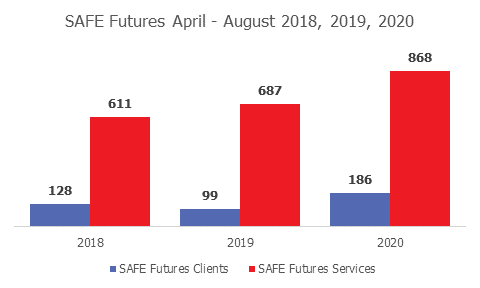SAFE Futures: Helping families stay strong
Written by SAFE
Janice is a military veteran and mother to a 3 year old. Early on, her partner was not physically violent. He was extremely controlling and emotionally abusive—which are every bit as serious—but he didn’t hit her. Like many people, Janice didn’t consider what she was experiencing abuse because it wasn’t physical.
But it wasn’t long before he became physically violent. During a particularly violent episode, a neighbor called the police. From there, Child Protective Services removed Janice’s daughter, placing her in foster care.
Janice was desperate to be reunited with her daughter and followed all of the court’s requirements, including taking classes related to domestic violence offered by SAFE. At this class, she learned about SAFE Futures, our program that provides specialized services for Travis County area families who have experienced family violence and are involved with the child welfare system.
Through SAFE Futures, she enrolled herself in advocacy services and was assigned a Family Court Legal Advocate who understood the complicated dynamics at the intersection of domestic violence and the child welfare system. The SAFE advocate met with Janice about her case, helping her understand and identify additional services she could take, like counseling and peer support groups, and to coordinate information with her attorney and CPS caseworker.
Advocating for Janice
While in this process, Janice met someone new and began a relationship with him. As many abusive relationships do, this one moved quickly. They moved in together and Janice became pregnant. Her partner started out as a doting boyfriend, but once Janice was pregnant red flag behaviors that she had seen in her previous abusive partner started to emerge. Thanks to her domestic violence classes at SAFE, she was able to recognize these red flags and leave before the abuse became physical.
While her CPS case had been moving toward reunification with her daughter, her CPS caseworker saw Janice leaving her boyfriend and home as an unstable move. They shifted the proceedings toward keeping her daughter in foster care.
Between October 2018 and September 2019, 68% of families served were able to maintain custody of, or be reunified with, their children. This enabled more children to remain with a non-abusive parent who is safe and prepared to parent effectively.
However, her SAFE advocate recognized Janice’s quick exit from an abusive relationship as a strength and called the CPS liaison with whom SAFE has built a strong and trusting relationship. The CPS liaison then consulted the CPS caseworker and her supervisor to assess and understand the case’s direction. Through SAFE’s advocacy and direct relationships with those in the child welfare system, Janice’s support network was quickly able to come together for a Family Group Conference which began the process for Janice’s daughter to return home.
Success for the child, the family, and the State.
What exactly is SAFE Futures?
SAFE Futures is a program of SAFE, providing:
- Specialized services for Travis County area families who have experienced family violence and are involved with the child welfare system
- Survivor education about domestic violence and protective parenting
- Comprehensive case management
- Legal advocacy
Participants are generally court ordered or CPS referred to participate in survivor education, and then move into legal advocacy/support. Parents receive assistance in navigating the child welfare system, meeting court requirements, and maintaining or regaining their parental rights.
Through SAFE Futures, parents are better able to build and maintain healthy relationships with their children, improve their parenting skills, and enhance the resiliency of the family, thereby keeping children out of the foster care system and preventing the many associated disparities (including future homelessness, incarceration, drug and alcohol abuse, violence and victimization, and health disparities.)
SAFE Futures and COVID-19
During the pandemic we have seen a significant increase in the number of people receiving services through SAFE Futures, as well as the services received per client, as demonstrated in the graph below, detailing year-over-year comparison of service numbers for the same months.

The problem SAFE Futures is addressing
Domestic violence in the home is the single greatest predictor for child abuse fatality, and it is estimated that 30-60% of children from homes where domestic violence is present are also victims of abuse. In 2018, there were 197,027 reported incidences of family violence in Texas, and 49,525 Texas children in state care. While removing a child from a violent situation is vital for their safety and wellbeing, they are too often also removed from the care of a non-violent, non-offending parent, thus creating further negative outcomes for parents and children.
Child welfare systems, domestic violence and social service agencies, as well as juvenile, family, and criminal court systems, presently operate from disparate philosophies, policies, and practices. While these stakeholders have seemingly common goals in protecting children and families, their inconsistencies in approach too often see children being placed in costly and damaging out-of-home care. This can lead to negative outcomes for children and parents.
Program effectiveness
Travis County Family Court Judge, Aurora Martinez-Jones, has described SAFE Futures as, “A game-changer for families.” Between October 2018 and September 2019, 68% of families served were able to maintain custody of, or be reunified with, their children. This enabled more children to remain with a non-abusive parent who is safe and prepared to parent effectively. It also helped keep children out of the foster care system. In the short- and long-term, this project affords significant state-based cost savings by preventing costly negative health and social outcomes.
SAFE Futures utilizes evidence-informed models and curricula. For survivors who have been mandated by CPS to attend parenting classes, SAFE Futures implements our SAFE and Protective Parenting curriculum, addressing protective strategies for child-rearing in families that have encountered violence. In 2019, 96% of parents reported feeling more confident in creating a safe and nurturing environment for their children. For families requiring further parenting support, we also refer to our Strong Start home visiting program, which utilizes the Nurturing Parenting curriculum. It is recognized by the Office of Juvenile Justice and Delinquency and designed to build nurturing parenting skills. Reviews of this curriculum report significant reductions in incidences and re-reports of child maltreatment.
SAFE also trains child welfare professionals using the internationally recognized Safe and Together Model, designed to help child welfare professionals become domestic violence-informed. In 2019, 100% of child welfare professionals attending training provided by SAFE reported an increase in skills working with families who have experienced domestic violence.
Current status
This program has been funded for the last four years through a federal grant from the US Department of Health and Human Services, Family Violence Prevention Services Act (FVPSA). SAFE was notified last year that the grant would not be renewed beyond its fourth year because of the predetermined term of the grant.
“SAFE Futures program has achieved a great many and significant impacts in its communities since the inception of this demonstration project. As a result, many survivors and their children are safer due to the hard work and dedication of your organization and its staff. The entirety of your project has created a strong and solid foundation for continued success and growth!”
— Quote from federal partner
SAFE has pursued multiple funding options, including DFPS funding, a no-cost extension through FVPSA, and has a philanthropic grant outstanding. The FVPSA grant provided approximately $300,000 annually to SAFE to provide the services, with an additional $200,000 that has been subcontracted to three additional agencies. SAFE has notified the sub-contracting agencies that the grant will be ending as will the subcontracted funding.
SAFE Futures is at the core of SAFE’s mission to stop abuse for everyone. Most importantly–it works. Lives are being saved today and for future generations. SAFE is continuing to work toward securing funding for this critical program.